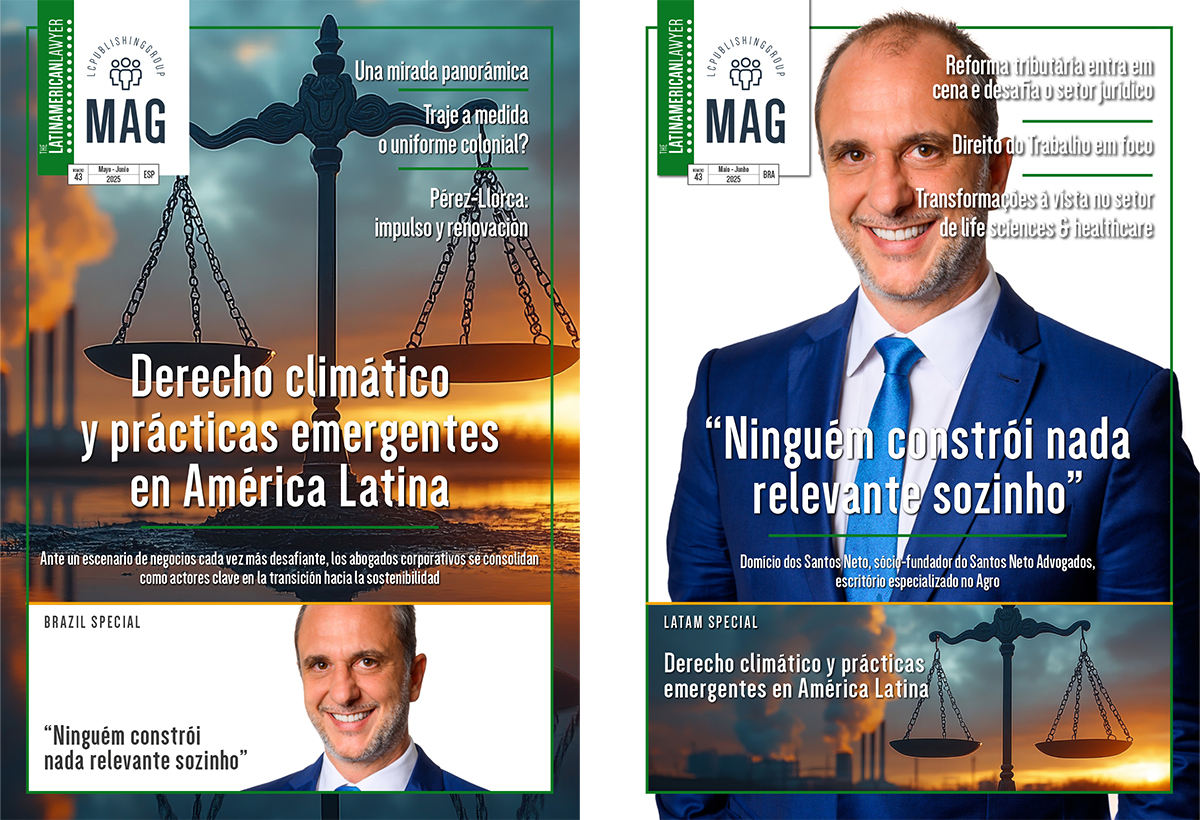Latin America Special Report 2010: Adapting to local realities
Latin America remains a favoured destination for Spanish and Portuguese businesses, who have invested heavily over recent decades, but regional variations in investor attraction continue to exist.
There is no doubt that Latin America is now experiencing unprecedented levels of international interest. Driven in part by lower investment returns and opportunities elsewhere, international businesses are looking to capitalise on the regions’ expanding economies, growing middle classes, and relative immunity to the financial crisis that has so clearly impacted on the US and Europe.
“In previous decades, there was an evident resistance to foreign investment in parts ofin America practice from t Latin America. Now the reverse is true, there is a virtual ‘welcome mat’ and people are sitting up and taking notice,” says Fernando Alonso, who leads the Lathe Miami office of Hunton & Williams.
The region is now characterised by its relatively young population, a growing middle class and unprecedented political and economic stability. Regional economic blocs are also now growing in importance globally, while a number of Latin American’s major companies, multilatinas, are looking to expand across and out of the region and into the US, Europe and Asia.
Ideological resistance to private sector investment may still be encountered in countries such as Venezuela and Bolivia, and there may now be reduced interest in countries such as Argentina, as it experiences both political and economic peaks and troughs, but the rest of the continent is embracing and experiencing significant levels of investment, say lawyers.
Everyone’s favourite
Brazil, more than any country in the region, is the current destination of choice for businesses looking to launch or expand their Latin American portfolios, say lawyers.
“The unique situation evident in Brazil is not merely the result of an expanding economy but careful economic planning. The effect of the global financial crisis has been felt very differently in each of the Latin American countries, basically because of the different levels of external debt each of them held,” says Henrique Dias Carneiro, partner at São Paulo-based Dias Carneiro Advogados – associated with Uría Menéndez.
Recent headlines have seen a number of leading Iberian infrastructure and banks expand their profiles and operational portfolios across the country. Santander last year successfully undertook the world’s largest IPO – the partial €5.4bn flotation of Santander Brasil – and a €7.5bn battle for control has waged for mobile telecoms operator Vivo, between joint owners Telefonica and Portugal Telecom (PT), as both have looked to expand their operations in the country.
In recent months Garrigues – which advised PT in the Vivo contest – has announced it is to open its own office in the country and form an association with Rio de Janeiro-based Schmidt Valois Miranda Ferreira & Agel – Advogados (SVFMA). Likewise, DLA Piper earlier in the year announced an association with 60-lawyer firm Campos Mello Advogados. While US firms including Chadbourne & Parke, Milbank Tweed Hadley McCloy and Simpson Thatcher & Bartlett have also all opened Brazilian offices recently.
Cuatrecasas and Gómez-Acebo & Pombo also have established referral networks across the region, as do the leading Portuguese firms, including PLMJ, Vieira de Almeida and Morais Leitão Galvão Teles Soares da Silva & Associados.
According to Thompson Reuters, M&A activity in Latin America rose by 171% in the second quarter of 2010 with Brazil accounting for over €1.8 billion worth of completed deals.
“Brazil has dedicated the last decade to increasing its capacity to pay its external debt, increase exports, and become less dependent on imported oil.
These measures, aligned with severe regulation, almost banning investments made by Brazilian institutions abroad, has resulted in a less severe impact of the crisis on the country’s economy and the possibility of being the last to enter into, and the first to come out of, it,” says Dias Carneiro.
Moreover, Brazil’s economic health is allowing the Government to introduce measures aiming to help other countries of South America to survive the global financial crisis.

“Our economy is doing better not only in comparison to our immediate neighbours but also in comparison to other economies as well. Our first quarter has shown an increase in GDP second only to China,” says José Luis Freire, founding partner of Brazil’s TozziniFreire.
The country’s exports may have suffered in line with a drop in consumer spending globally, but he points out that exports represent only 15% of the Brazilian GDP. A decrease that was compensated for by rising internal consumption, boosted by tax incentives, longer credit terms and an increase in the income of both skilled and unskilled workers.
July saw US private equity fund Carlyle Group pay US$1.2bn for Brazilian health services provider Grupo Qualicorp as it looks to capitalise on demand from the country’s growing middle class. The acquisition funded by its $13.7bn V fund and South America Buyout Fund.
“Brazil is quickly becoming the most desired port for foreign investment. The offshore pre-salt oil exploration areas will also foster significant foreign investment in the country. All these events will increase even more the local economic activity, and we should also mention our capital markets, which are recovering too. IPOs are coming back and they are bringing with them unexpected investment,” says Freire.
But the flow is beginning to become two-way. Brazilian state energy company Petrobras is increasingly present in European, notably Portuguese operations. Mining giant Vale is looking to Africa, while a three way battle for control of Portugal’s largest cement producer has also been waged. Brazilian cement and steel producers Companhia Siderúgica Nacional (CSN), Votorantim and Camargo Corrêa continue to fight for control of Cimpor, as they search for resources and know-how ahead of the country’s hosting of the 2014 FIFA World Cup and the 2016 Olympics and an expected up turn in infrastructure projects.
Catching a cold
But there is more to Latin America than Brazil. Second on many businesses’ regional target lists is Mexico. For an economy still highly dependent on the economic health of its northern neighbour, the US, the past year was not however particularly kind, say lawyers there.
“When America catches a cold, Mexico gets pneumonia,” says Daniel Del Rio, partner with Mexico City-based Basham Ringe & Correa. The combined effects of the financial crisis and regional economic downturn, along with the outbreak of swine flu, meant negative growth last year of -7 per cent, but the year to date has been significantly better.
“2010 is a different story, with the rebound of the US economy, Mexico has once again experienced growth as US exports represent around 80% of what Mexico sells abroad,” he says. “We foresee the coming year offering more investment opportunities and figures to return to 2008 levels. Nevertheless, Mexico is still in need of major reforms such as tax, labor, telecoms, as well as the energy sectors.”
Mexico’s leading telecoms operator Telmex – owned by Carlos Slim – is however now an established regional powerhouse, its 2004 acquistion of AT&T’s Latin American operations, helping to extend the country’s reach across Colombia, Peru, Chile, Arentina, Uruguay and Brazil, where it owns the country’s number two operator Embratel.
Likewise, Mexico’s Cemex is now the world’s largest building materials supplier and third largest cement producer. Last year saw it undertake a major refinancing of its estimated $15bn debt through its European headquarters in Madrid – the deal seeing Uría Menéndez act alongside Slaughter and May and Skadden Arps Slate Meagher & Flom, with Clifford Chance and Cleary Gottlieb Steen & Hamilton advising the creditor syndicate.
Part of the reason for the economic bounce has been the robustness of the country’s banks, says Del Rio. “The expectation is that economic growth will return to around 4.5-5% this year. Mexico’s banks have remained strong while reform of the domestic pension funds (Afores) has also allowed them to become more flexible, giving the opportunity of investing in a wider range of financial instruments so improving liquidity.”
Latin America’s banking system is considered to have learnt the lessons of previous financial crises and weathered the current global downturn with a mixture of caution and strong regulation. Most banks still operate along national lines, and many therefore consider the opportunity for cross-border mergers.
Spain’s BBVA is already the major domestic player in Mexico, through its local subsidiary BBVA Bancomer, while Santander is also now placing renewed emphasis there. It recently announced the purchase of Bank of America’s minority stake in its Mexican operations giving it back full control of the business. The Spanish bank has agreed to pay $2.5bn (€1.88bn) for the 25% stake that it sold to the US bank in 2003 for $1.6bn.

The deal deepens Santander’s Latin America coverage where it already generates an estimated 40% of its revenues – it has an estimated market share of 10- 20% across Argentina, Brazil, Mexico, Chile and Uruguay.
Contagious
Central America too has vicariously felt the effects of the economic downturn in the US. With the region seeing economic growth contract by around 0.5%, says Mauricio Salas, a partner with Costa Rica’s BLP Abogados – the decline is the result predominantly of a fall in tourism, changing consumption patterns, and lower foreign direct investment and remittances from its main economic partners, the US and Spain.
The implementation of the Dominican Republic – Central America Free Trade Area (DR-CAFTA) has helped to open up the region’s economies, but it has also meant that economic contagion – positive or negative – spread more quickly.
The Costa Rican economy is doing reasonably well under the circumstances but the recovery is fragile and largely dependent on external factors, such as demand in the US and developments in the euro zone,” he says.
The country nonetheless has fared better than some of its neighbours, he believes, in terms of unemployment and remittance vulnerability. Tourism rates appear to be improving, as are agricultural exports, but the real estate and second home markets still show no signs of recovery.
“Such changes are evidently felt in the legal market, as firms’ once booming real estate practices are now stagnant. Major infrastructure projects have however helped Panama avoid recession despite the global downturn in trade. Our once trailing neighbour is quickly gaining ground on us,” says Salas.
Panama has now embarked on its US$5.25bn ‘Third Set of Locks Project’ that will double the capacity of the Canal by 2014. The project sees the construction of two new lock complexes—one on the Atlantic side and another on the Pacific side – new access channels and the widening and deepening of the existing channels. The project driven by rising sea freight volumes and vessel size, is expected to generate revenue of around $6.2bn by 2025. Spanish contruction company Sacyr is among the lead contractors.
In from the cold
Even some of the countries that once proved more challenging to international investors are now of much greater interest, say lawyers.
Among them Peru, Uruguay and especially Colombia, where Spanish banks and financial institutions including BBVA, Santander, MAPFRE, as well as companies such as Planeta, Prisa, Sanitas and Telefonica are all now active. Additionally, construction and infrastructure companies such as OHL are looking at new opportunities, as are Gas Natural – Union Fenosa, Endesa and Agbar.

“There remain plenty of opportunities in Colombia for Spanish and Portuguese businesses expanding into the region. Against all odds, Colombia has become the country to watch in the hemisphere,” says Alejandro Linares-Cantillo, partner with Bogotá’s Gómez-Pinzón Zuleta Abogados.
Others countries however continue to present challenges, say lawyers. Idealogical opposition to increased private investment is clearly evident in Venezuela and Bolivia, where opportunities nonetheless exist but require careful planning and an intricate understanding of both the prevailing economic and political drivers.
Argentina too presents issues, say some. The country’s sovereign debt default at the start of the millennium continues to be felt in reduced levels of international investor confidence and the consumption and spending habits of its citizens. In addition the government’s political focus, and nationalisation of entities such as Aerolineas Argentinas, a subsidiary of Spain’s Marsans, has also done little to encourage foreign investors.
“Unlike our neighbour’s – notably Chile, Peru and Brazil – Argentina has not received the same strong influx of foreign investment over the past decade and therefore its growth has been the result mostly of rising internal consumption and expansionary fiscal policies, this has now however led to an inflation problem,” says Tomas Miguel Araya at Buenos Aires’ M&M Bomchil.
Except for some collateral effects on recent Government bond swaps, the global financial crisis has therefore had relatively little direct impact in Argentina.
The country’s peculiarities mean that there is little possibility of negative economic contagion from its neighbours, indeed there is hope that the rise in fortunes of Brazil especially may help boost domestic demand notably in the country’s automotive industry.
“There remains a degree of caution among people towards utilising the domestic finance and banking system, and so with minimal deposits there is minimal lending. There is instead an emphasis on consumerism, which means that many local businesses are conversely doing very well,” says Alberto Lasheras-Shine, partner with Buenos Aires’ Estudio Beccar Varela.
The country’s economy may therefore still be growing but this is very much influenced by government spending. Despite the imposition of highly unpopular taxes on the country’s major agricultural exports, notably soy, Argentina has not managed to capitalise on the past decade’s commodities price boom. The official rate of inflation may be 15% but in reality it is closer to 25%.
“Investors need economic, political and legal certainty and for too long we have had varying degrees of either. We have recently however seen some positive developments at the Supreme Court, notably in reducing the impact of some of the Government’s more puzzling policies,” says Lasheras-Shine. “Many of us are now more optimistic that we are beginning to see light at the end of the tunnel – albeit always thinking that it might yet however be another train coming towards us.”
Latin America is therefore both a real and a fictional concept, say lawyers. The region may be performing better than others around the world, but strong differences remain in economic performance and investor appetite among individual countries. There is no doubting however that the basic attractions of the region continue to exist. The challenge for investors is to adapt their expectations and operational methods to the local reality.















